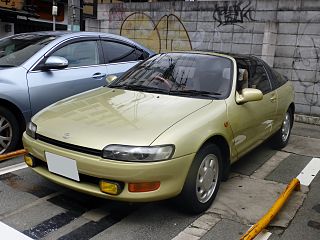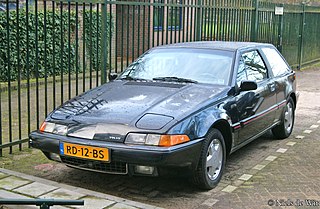
The Saab 900 is a mid-sized automobile produced by Swedish manufacturer Saab from 1978 until 1998 in two generations: the first from 1978 to 1994, and the second from 1994 to 1998.

The Honda Accord, also known as the Honda Inspire in Japan and China for certain generations, is a series of automobiles manufactured by Honda since 1976, best known for its four-door sedan variant, which has been one of the best-selling cars in the United States since 1989. The Accord nameplate has been applied to a variety of vehicles worldwide, including coupes, station wagons, hatchbacks and a Honda Crosstour crossover.

The Eagle Talon is a sport compact hatchback coupé manufactured as part of a joint venture between Chrysler and Mitsubishi in two generations starting from the 1989 model year.

The Renault Laguna is a large family car that was manufactured and marketed by Renault for 21 years in three body styles: hatchback, coupé, and estate. The first generation Laguna was launched in 1994, the second generation was introduced in 2000, and the third generation was built from October 2007 until 2015.

The Volvo C30 is a three-door, front-engine, front-wheel-drive premium compact hatchback manufactured and marketed by Volvo Cars from 2006 to 2013, in a single generation. Powered by inline-four and straight-five engines, the C30 is a variant of the Volvo S40/V50/C70 range, sharing the same Ford C1/Volvo P1 platform. Volvo marketed the C30 as a premium hatchback / sports coupe.

The Opel Calibra is a coupé, engineered and produced by the German automaker Opel between 1989 and 1997. In the United Kingdom, where it remained on sale until 1999, it was marketed under the Vauxhall brand as the Vauxhall Calibra. It was also marketed as the Chevrolet Calibra in South America by Chevrolet, and the Holden Calibra in Australia and New Zealand by Holden.

In the automotive industry, a gull-wing door, also known as a falcon-wing door or an up-door, is a car door that is hinged at the roof rather than the side, as pioneered by Mercedes-Benz 300 SL, first as a race car in 1952 (W194), and then as a production sports car in 1954.

The Toyota Sera is a 3-door 2+2 hatchback coupe manufactured and marketed by Toyota from 1990 to 1996. It was only officially sold in Japan.

The Volvo 480 is a sporty compact car that was produced in Born, Netherlands, by Volvo from 1986 to 1995. It was the first front-wheel drive car made by Volvo and the only Volvo featuring pop-up headlights. The 480 was available in only one body style on an automobile platform related to the Volvo 440/460 five-door hatchback and four-door saloon models.

The trunk or boot of a car is the vehicle's main storage or cargo compartment, often a hatch at the rear of the vehicle. It can also be called a tailgate.

The Mazda Kabura is a concept car shown by the Japanese manufacturer Mazda in 2006.
The following outline is provided as an overview of and topical guide to automobiles:

The Toyota Corolla E80 is a range of small automobiles manufactured and marketed by Toyota from 1983 to 1987 as the fifth generation of cars under the Corolla and Toyota Sprinter nameplates, with production totaling approximately 3.3 million, and most models adopting a front-wheel drive layout.

The third-generation Honda Civic is an automobile which was produced by Honda from 1983 until 1987. It was introduced in September 1983 for the 1984 model year. The Civic's wheelbase was increased by 2–5 inches (13 cm) to 93.7 inches (hatchback) or 96.5 inches (sedan). A three-door hatchback/kammback, four-door sedan, the five-door "Shuttle" station wagon, and sporting CRX coupé shared common underpinnings. This included MacPherson strut suspension with torsion bars in the front and a rear beam with coil springs. However, the body panels were largely different between models. The Civic-based Honda Quint five-door hatchback also underwent a model change, and became the Honda Quint Integra, available as both a three- and five-door fastback. The Quint Integra was sold at the Japanese Honda Verno dealership along with the CR-X. The Civic in Japan was now exclusive to Honda Primo, along with Honda's kei cars as well as superminis like the Honda City.

The fifth-generation Honda Civic is an automobile produced by Honda from 1991 until 1995. It debuted in Japan on September 9, 1991. At its introduction, it won the Car of the Year Japan award for the second time. Fifth-generation Civics were larger than their predecessors, had more aerodynamic bodies, and the wheelbase was increased to 257 cm (101.3 inches)—for the three-door hatchback—and to 262 cm (103.2 inches)—for the four-door sedan. The Civic Shuttle station wagon was not part of the fifth generation and was dropped for overseas markets, while the previous-generation wagon continued in Japan and Europe.

The sixth-generation Honda Civic is an automobile produced by Honda from 1995 until 2000. It was introduced in 1995 with 3-door hatchback, 4-door sedan and 2-door coupe body styles, replicating its predecessor's lineup. The sixth-generation Civic offered two new 1.6-liter 4-cylinder engines and a new continuously variable transmission (CVT) on the HX model. The coupe and sedan are 2.3 in (58 mm) longer and the hatchback is 4.3 in (109 mm) longer than the previous-generation Civic. This was the last generation of Civic to have front double-wishbone suspension, as the succeeding seventh generation would change the front suspension to a MacPherson strut.

The seventh-generation Honda Civic is an automobile produced by Honda from 2000 until 2005. It debuted in September 2000 as a 2001 model. Its exterior dimensions stayed similar to the outgoing predecessor, with interior space significantly increased, bumping it up to the compact car size designation. A notable feature was the flat rear floor that gave better comfort to the rear seat passengers. This generation abandoned the front double wishbone suspension, used previously from fourth to sixth generations, replacing it with MacPherson struts. This generation was the last to offer 4WD variants.

The eighth-generation Honda Civic is a range of compact cars (C-segment) manufactured by Honda between 2005 and 2012, replacing the seventh-generation Civic. Four body styles were introduced throughout its production run, which are sedan, coupe, and both three-door and five-door hatchback. The sedan version was introduced with two distinct styling for different markets, with one of them sold as the Acura CSX in Canada and as the Ciimo 1.8 in China from 2012 until 2016. The hatchback versions formed the European-market Civic range, which received a different architecture, body design and smaller footprint, and solely produced in Swindon, United Kingdom.

The ninth-generation Honda Civic is a range of compact cars (C-segment) manufactured by Honda between 2011 and 2016, replacing the eighth-generation Civic. It was launched in the North American market in April 2011, Europe in February 2012 and Asia-Pacific in early 2012. Four body styles were introduced throughout its production run, which are sedan, coupe, hatchback and a station wagon version marketed as the Civic Tourer. The latter two make up for the European-market Civic range, which was produced in Swindon, United Kingdom, and received a completely different design and smaller exterior size. The hatchback version forms a basis for a Civic Type R (FK2) model, which was released later in 2015.


















